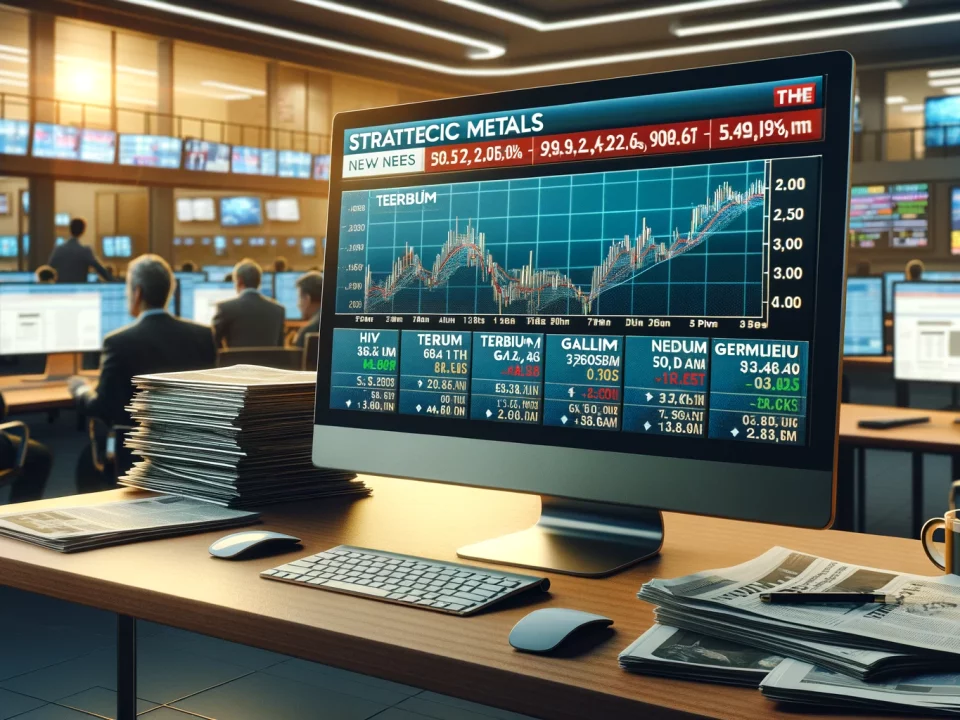
From Crisis to Profit: Why Strategic Metals are Today’s Must-Have Asset
October 30, 2024
Weekly News Review November 4 – November 10 2024
November 10, 2024Welcome to our weekly news review.
INTERNATIONAL ENERGY ASSOCIATION: MARKET SIZE OF CLEAN ENERGY TECHNOLOGIES CLOSING IN ON CRUDE OIL –
According to the International Energy Agency (IEA), the market size of clean energy technologies is expected to almost triple from $700 billion today to $2 trillion in 2035. In its latest report, Energy Technology Perspectives 2024, the agency sheds light on how the six most adopted and manufactured clean energy technologies—solar photovoltaics, wind turbines, electric vehicles, batteries, electrolyzers, and heat pumps—are shaping global trade and manufacturing.
The IEA emphasized that a market size of $2 trillion in 2035 would be close to today’s global crude oil market size. Cleantech trade alone could reach $575 billion in a decade, surpassing the global natural gas trade.
Yet, the growth in clean energy technologies is not homogenous worldwide. Countries with clear-cut and widespread policies regarding clean energy, especially China, the European Union, the United States, and India, are leading in clean tech investments.
Despite the Inflation Reduction Act in the U.S. and the E.U.’s Net-Zero Industry Act, China is set to dominate the market, with projected clean tech exports hitting $340 billion by 2035.
The IEA highlights that developing and emerging countries hold vast potential to shift global market concentration. Despite generating less than five percent of cleantech production value, they could become hubs for producing certain goods. The agency references Southeast Asia’s competitiveness in producing solar components, Latin America’s wind turbine capacity, and North Africa’s potential as an E.V. manufacturing hub.
The IEA says these regions also hold vast resources of critical minerals needed for cleantech worldwide. Developing and emerging nations could move up the value chain from mining to processing and capitalize more on the raw materials’ value. One example of this already happening is Indonesia, which banned the export of certain unrefined raw materials last year, hoping to develop the domestic downstream value chain further.
CHINA PLEDGES TO BOOST RENEWABLES FURTHER:
On Wednesday, the Chinese government published guidelines on replacing fossil fuels with renewable energies. Released by the National Development and Reform Commission and five other government departments, the regulations outline how the People’s Republic seeks to boost its clean energy sector to achieve the self-proclaimed carbon peak target in 2030.
According to the statement, China expects to reach a renewable energy consumption of more than 1.1 billion tons of standard coal in 2025 and exceed the equivalent of 1.5 billion tons by 2030.
The 17 guidelines, among other things, aim to accelerate the construction of large-scale wind power and photovoltaic systems and ramp up green fuel usages such as biodiesel or hydrogen. In addition, China aims to upgrade energy grids and energy storage systems and electrify transportation, infrastructure, and buildings. Heavy industries, such as the chemical sector or steel manufacturing, are also set to be transferred to renewable usage under the regulations, as is agriculture.
The International Energy Agency (IEA) highlighted in a new report this week that China is set to dominate the clean energy sector in the coming decades, in part because of widespread policies issued by the government. Another key element of the People’s Republic’s success is its dominance in the critical minerals sector. The raw materials are needed for various clean energy technologies.
However, the agency highlighted that efforts in other countries, such as the U.S. Inflation Reduction Act and the E.U.’s Net-Zero Industry Act, would also help triple the market size of clean energy technologies until 2035.
US GOVERNMENT ALLOCATES $45 MILLION TO ELECTRIC VEHICLE BATTERY RECYCLING PROJECTS:
Eight projects focus on recycling batteries and components to strengthen domestic supply chains.
On Thursday, the United States Department of Energy (DOE) announced $44.8 million in funding for eight projects recycling electric vehicle batteries and battery components to strengthen domestic supply chains. With the funds, the companies aim to simplify recycling and reduce overall costs by developing new dismantling methods and battery package designs.
According to the DOE, facilitating the reusability of batteries is critical to strengthening domestic supply chains and reducing pollution. With a ramp-up in electric vehicle sales in recent years, more are eventually reaching their end-of-life. According to the International Council on Clean Transportation, improperly discarded batteries are hazardous to the environment and human health.
In combination with the economic prospects of recovering the critical minerals contained within them, such as lithium or cobalt, battery recycling is becoming increasingly relevant. However, it is a complex and costly process with current methods, a report by consultancy EY argues (PDF). Manual disassembly is almost always required during the process, as no standardized battery pack designs exist. This also hinders the implementation of automation. The consultancy argues that the concept of recycling must begin in the product design stage.
The now-announced funding by the U.S. government seeks to address these issues. Caterpillar, for example, will work on improved battery packages designed that are easier to recycle, while Siemens is exploring automation in the field. General Motors, on the other hand, is researching a de-hazarding system that can be used by recyclers, dealers, and mechanic shops.
German associations in the field recently highlighted the challenges to large-scale battery recycling, calling for definitive policies regarding battery circularity. They also argued that recyclability must be embedded in product design to avoid challenges in disassembly and prevent quality losses in the recovered materials.
INDIA AND UK TO JOIN FORCES:
New partnership between research and industry to drive sustainable mining, refining, and recycling.
A new partnership between India and the United Kingdom aims to strengthen the supply of critical raw materials. Leading the initiative are the UK-based Centre for Process Innovation Limited (CPI), the Institute for Manufacturing (IfM) at the University of Cambridge, and the Indian Institute of Technology (IIT) Bombay.
The collaboration includes plans for a monitoring hub to connect research and industry through data sharing on supply chains. The goal is to track the flow of critical minerals—from mines to electric vehicles—to identify risks, recycling opportunities, and potential bottlenecks. At the same time, the initiative aims to boost innovation and investment along the entire value chain. This approach creates economic opportunities in both the U.K. and India while jointly building future industries, said Dr. Arun Harish, Chief Strategy Officer at CPI. The platform’s development will also explore emerging technologies such as personalized artificial intelligence.
According to the press release, both countries acknowledge the “urgent need for action” to ensure responsible mining, refining, and recycling of critical minerals and to support the transition to net zero.
This new initiative builds on the existing bilateral cooperation established under the India-UK Roadmap 2030. Both nations also collaborate in strategic sectors like rare earth elements and renewable energy and are members of the Minerals Security Partnership, a global initiative to promote sustainable supply chains.
India and the U.K. are increasing domestic mining and recycling and forming new partnerships for critical materials to reduce their dependency on Chinese imports. As an emerging economic power, India released its first list of critical minerals last year to support its growing technology sector. Also, last year, the U.K. updated its strategy for these strategic materials.
UK AIMS TO REDUCE DEPENDENCE ON CHINA:
Chancellor of the Exchequer Reeves announces access to export financing.
British Chancellor of the Exchequer Rachel Reeves plans to support domestic companies that import critical minerals by providing government-backed loans, aiming to reduce dependence on China. Bloomberg (paywall) reported this, citing individuals familiar with the matter. Importers of raw materials such as lithium, graphite, and cobalt, which are designated for manufacturing in the United Kingdom, are to gain access to the U.K. Export Finance Agency (UKEF).
According to another source quoted by the Financial Times (paywall), this would fill an existing funding gap. The new initiative is intended to facilitate financing agreements with suppliers in resource-rich Commonwealth countries like Australia, as per sources cited by Bloomberg. Officially, the measure will be announced in the budget plans next week.
Like many other Western countries, the United Kingdom aims to diversify its supply chains for strategic sectors such as renewable energy and defense amid increasing geopolitical tensions. New partnerships for raw materials and increased domestic production and recycling play an essential role in these efforts. In the past, various projects have already received government support; beyond funding research and industrial projects, the U.K. government’s purchase of an ailing semiconductor factory made headlines.
Other European countries, including France, Italy, and most recently Germany, have established state-backed raw materials funds to facilitate investments in domestic and foreign projects.
AUSTRALIA: REVENUE DECLINE AT RARE EARTH SPECIALIST LYNAS CORP –
The Australian company Lynas, the largest producer of rare earths outside China, presented its figures for the first quarter of the 2025 financial year on Wednesday (PDF). The company reported a nearly six percent decline in revenue compared to last year’s period, totaling approximately $79 million (AUS$120 million).
As in the last quarter, Lynas pointed to its products’ currently low price level. However, it was noted that by the end of the quarter, an improvement had begun to emerge, at least for neodymium-praseodymium.
EU TARIFFS ON CHINESE ELECTRIC VEHICLES: CRITICISM FROM BOTH SIDES –
China calls it protectionism, but the German auto industry fears disadvantages.
Starting today, the E.U.’s special tariffs on electric vehicles made in China are in effect. The union justifies the measure with claims of unfair competitive advantages due to state subsidies, including tax breaks and state-provided components and raw materials at prices below market value. About a year ago, the European Commission launched an anti-subsidy investigation, which it announced yesterday had concluded positively. On the same day, the tariffs were published in the E.U.’s Official Journal to take effect the following day.
The measure is set to last five years. According to the E.U., specific tariff rates are 17% for BYD, 18.8% for Geely, 35.3% for SAIC, and 20.7% for other cooperating companies. Non-cooperating automakers face a 35.3% tariff, while the U.S. company Tesla, which also manufactures in China, will face a 7.8% tariff upon “justified request” and individual review.
In parallel, the E.U. announced it is working with China on an alternative solution that complies with World Trade Organization (WTO) rules and is open to negotiations with individual exporters. Importers can also request a refund if they believe the relevant company is not receiving subsidies, but they must provide supporting evidence.
German Automotive Industry: Concern Over Trade Conflict:
Earlier this month, a sufficient majority of E.U. countries voted in favor of the tariffs, reports German news channel ZDF, with Germany voting against them. China is a crucial market for the German auto industry, with some German manufacturers producing there for export. The industry has thus criticized the tariffs’ introduction.
On Tuesday, the German Association of the Automotive Industry called it a “setback for free global trade and, consequently, for prosperity, job security, and growth in Europe.” The punitive tariffs, it warned, increase the risk of an extensive trade conflict.
As expected, sharp criticism also came from China itself. According to the state-affiliated Global Times, China does not recognize the E.U.’s decision on the anti-subsidy investigation and has filed a complaint with the WTO. China, in turn, accused the E.U. of “unfair trade protectionism.” Seen as a possible response, China has imposed a levy on European-made brandy and is continuing an anti-dumping and anti-subsidy investigation regarding E.U. pork.






